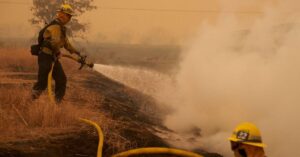Firefighters Unprecedented Wildfires Ravage Los Angeles Amid Blustery Conditions
Amidst blustery conditions, local fire officials are facing what they have termed a “worst-case scenario” in their battle against the raging wildfires that are currently devastating Los Angeles. The ferocious Santa Ana winds, with reports of gusts reaching up to 100 mph near Pasadena, have created a perfect storm for the rapid spread of these wildfires. Fox Meteorologist Christopher Tate has highlighted the critical role of these winds in fueling the fires, as they not only fan the flames but also disperse smoke and burned matter, providing ample oxygen to further intensify the blazes.
The dry conditions in Los Angeles have only exacerbated the situation, with relative humidity plummeting below 20 percent across the metropolitan area. This combination of extreme weather conditions has led to a catastrophic situation where the fires have already consumed over 3,000 acres of land, including numerous homes, with no containment in sight as of Wednesday morning.
California Governor Gavin Newsom has declared a state of emergency in response to the escalating crisis, underscoring the gravity of the situation and the urgent need for coordinated efforts to combat the wildfires and protect lives and property.
The Impact of Blustery Conditions on Wildfire Propagation
Understanding the role of blustery conditions, particularly the Santa Ana winds, is crucial in comprehending the unprecedented scale and intensity of the wildfires ravaging Los Angeles. These powerful winds, characterized by their dry and warm nature, create an ideal environment for wildfires to ignite and spread rapidly.
According to experts, such as Fox Meteorologist Christopher Tate, the Santa Ana winds not only fan the flames but also play a significant role in transporting smoke and burned particles away from the fires. This process, in turn, provides the fires with an abundant supply of oxygen, which is essential for their propagation. The ability of the winds to disperse smoke and burned matter over vast distances further exacerbates the situation, creating a scenario where multiple fires can spread uncontrollably.
Moreover, the dry conditions in Los Angeles, coupled with the low relative humidity levels, have created a tinderbox environment where even the smallest spark can ignite a massive conflagration. The combination of these factors has created a perfect storm that has overwhelmed firefighting efforts and posed a significant threat to both property and lives in the affected areas.
State of Emergency Declared as Wildfires Rage On
With the Firefighters in Los Angeles showing no signs of abating, California Governor Gavin Newsom has taken the decisive step of declaring a state of emergency. This declaration underscores the severity of the situation and the urgent need for additional resources and support to contain the fires and prevent further devastation.
As the fires continue to spread unchecked, the toll on the affected communities is mounting, with reports of homes being destroyed and residents being forced to evacuate to safety. The declaration of a state of emergency not only mobilizes state resources but also paves the way for federal assistance to be deployed in the firefighting efforts.
Governor Newsom’s swift action in declaring a state of emergency highlights the gravity of the crisis and the need for a coordinated response to mitigate the impact of the wildfires and protect the lives and livelihoods of those in harm’s way.
Looking Ahead: Challenges and Strategies in Wildfire Management
As the wildfires in Los Angeles continue to rage unabated, it is imperative to assess the challenges faced by firefighting agencies and develop effective strategies to manage and contain the fires. The unprecedented scale and intensity of the blazes underscore the need for a comprehensive approach that integrates various tactics and resources to combat the wildfires effectively.
One of the key challenges in managing the wildfires is the unpredictable nature of the blustery conditions, particularly the Santa Ana winds, which can rapidly shift direction and intensity, making firefighting efforts even more challenging. Firefighters must constantly adapt their strategies and tactics to respond to these changing conditions and prevent the fires from spreading further.
Furthermore, the dry conditions and low humidity levels in Los Angeles pose a significant challenge in containing the fires, as the parched landscape provides ample fuel for the flames to consume. Firefighters must work tirelessly to create firebreaks and contain the fires within manageable boundaries to prevent them from engulfing more homes and properties.
Additionally, the declaration of a state of emergency by Governor Newsom underscores the need for enhanced coordination and collaboration among state and federal agencies, as well as local communities, to effectively combat the wildfires and protect the affected areas. By pooling resources and expertise, stakeholders can work together to address the immediate threats posed by the wildfires and implement long-term strategies to mitigate the risk of future wildfires.
In conclusion, the wildfires ravaging Los Angeles amidst blustery conditions present a formidable challenge that requires a unified and coordinated response from all stakeholders. By understanding the impact of the Santa Ana winds, addressing the challenges posed by dry conditions, and implementing effective strategies for wildfire management, we can work towards containing the fires and safeguarding the communities affected by this ongoing crisis.
Discover What’s Trending Now in Our News Category!







